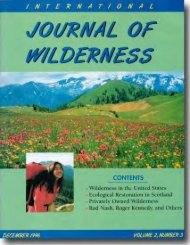Download full PDF - International Journal of Wilderness
Download full PDF - International Journal of Wilderness
Download full PDF - International Journal of Wilderness
Create successful ePaper yourself
Turn your PDF publications into a flip-book with our unique Google optimized e-Paper software.
•<br />
The vision <strong>of</strong> extending the Bialowieza National Park<br />
•<br />
into the entire Bialowieza Primeval Forest is one way<br />
to meet urgent conservation needs and to boost social<br />
and economic development in the region … .<br />
In spite <strong>of</strong> some losses that have<br />
already occurred, there is still time to<br />
maintain or restore a self-sustained<br />
ecosystem and to prevent further loss<br />
<strong>of</strong> biodiversity. Such a restoration <strong>of</strong><br />
natural processes and conditions requires<br />
a comprehensive management<br />
system involving natural disturbance<br />
patterns in the BNP and the entire BPF.<br />
Pressure for Forest Products<br />
According to the national forest agency<br />
(LP), Poland is too poor to “waste” a<br />
large amount <strong>of</strong> the marketable timber<br />
needed in the local economy. The<br />
claims that current forest management<br />
and harvesting is a required condition<br />
for the future <strong>of</strong> the BPF. However, due<br />
to long-term oversupply <strong>of</strong> cheap timber<br />
from Russia and Scandinavia, Polish<br />
forestry businesses are suffering<br />
from a deep economic recession. The<br />
•<br />
Riperian forest in the Bialowieza Primeval Forest. Photo by Andrzej Bobiec.<br />
LP forest management activity in the<br />
BPF (0.7% <strong>of</strong> the forestland in Poland)<br />
relies on national subsidies. The local<br />
economy, partly dependent on timber,<br />
does not necessarily need the relatively<br />
expensive wood from the BPF. For example,<br />
some community leaders complain<br />
that unless the trend <strong>of</strong> migration<br />
<strong>of</strong> young, educated people from the<br />
region to the large cities is reduced,<br />
the losses to the local social traditions<br />
and culture will be irreparable. Forestry<br />
seems to be <strong>of</strong> little interest to<br />
the local youth and has limited capacity<br />
to keep them in their hamlets.<br />
While “multipurpose forestry” is a<br />
driving paradigm in the European<br />
Union (where forests comparable to the<br />
BPF were gone 200 years ago), the LP<br />
arguments for forest management are<br />
also made on an ecological basis. The<br />
LP observes that foresters must eradi-<br />
36 <strong>International</strong> <strong>Journal</strong> <strong>of</strong> <strong>Wilderness</strong> DECEMBER 2002 • VOLUME 8, NUMBER 3<br />
cate forest pests, otherwise spruce will<br />
disappear. The LP claims they must<br />
help nature in remodeling stand composition<br />
to be better adapted to soil and<br />
the changing air quality in Poland.<br />
Extend the BNP into the<br />
Entire BPF?<br />
Since the beginning <strong>of</strong> the LP multipurpose<br />
forestry campaign, a great<br />
emphasis by conservationists was put<br />
on the socioeconomic aspects <strong>of</strong> legislation<br />
that supported the conservation<br />
<strong>of</strong> natural forests. According to the conservationists,<br />
the government is responsible<br />
for preservation <strong>of</strong> the remnants<br />
<strong>of</strong> natural forest as a living national<br />
monument and a laboratory <strong>of</strong> nature.<br />
They further claimed that the BPF was<br />
the best local and regional natural attraction<br />
and it should be both preserved<br />
and used by the local communities as<br />
an attraction, for visitors and tourists.<br />
In 2000, a group <strong>of</strong> volunteers—<br />
ecologists, biologists, and foresters—<br />
•<br />
mostly residents <strong>of</strong> the Bialowiza<br />
region, discussed the principles <strong>of</strong> the<br />
BNP and how they could be extended<br />
to the entire BPF in Poland. The project<br />
involved representatives <strong>of</strong> many stakeholder<br />
groups. According to their discussion,<br />
a national park covering the<br />
entire BPF is the best legal approach to<br />
secure conservation <strong>of</strong> the BPF. The<br />
national park management approach<br />
could use zoning to preserve the clusters<br />
<strong>of</strong> old-growth forest, wetlands, and<br />
breeding areas <strong>of</strong> rare wildlife species<br />
(e.g., bison, wolf, lynx, eagle). In forest<br />
restoration zones, moderate silviculture<br />
measures could be applied to mostly<br />
secondary growth and artificial stands,<br />
where management will restore natural<br />
forest systems while providing for<br />
locally needed firewood and raw wood<br />
material (approximately 70,000 cubic<br />
meters per year versus the 2001 extraction<br />
rate 120,000 cubic meters).










